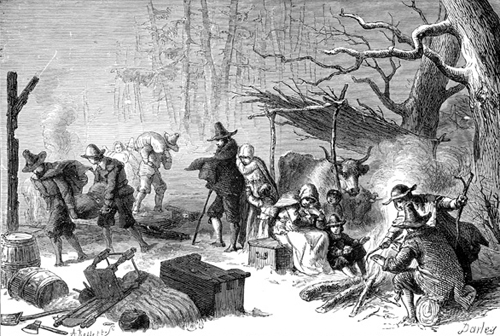By Dan Shine
Voice Columnist

West Haven’s Centennial
Part II
See: Part 1 | Part 3 | Part 4 | Part 5 | Part 6
To tell the story of West Haven, we first have to start with the story of New Haven, the first planned city in the New World, one that was laid out on a grid system of nine square blocks.
The New Haven Colony, settled in 1638, was the strictest of the colonies in its adherence to Puritanism; indeed, New Haven held fast to the Puritan way of life long after it had disappeared elsewhere.
New Haven’s 500 original settlers were the followers of the powerful and dynamic minister John Davenport, and his friend Theophilius Eaton; together they had come to this area by way of Boston. Finding Boston too liberal thinking for their ultra-conservative tastes, the group traveled again by ship to the place known as Quinnipiac, and settled there, renaming it New Haven.
The New Haven Colony had been founded by Puritans who were seeking religious freedom and a chance to increase their fortunes in the New World. However, the inescapable truth was that by 1647, the colony was in serious financial trouble–the colonists desperately needed to earn profits, that their colony might be sustained. But how?
They sought to build their fortunes through trade, thus they ordered the construction of a 150 ton ship for a trading voyage to England. In her hold would be “some pease, some wheat, all in bulk, with about two hundred W. India hides, and a store of beaver and plate.” The sale of these goods would bring much-needed profits to the aid of the suffering colonists.
Captain Lamberton was to command The Great Shippe, as she was called, even though he had no experience guiding a ship from the Colonies back to England. When he inspected the laden ship, he noted that she listed to one side; he subsequently described her as “walty” (likely to capsize). Nevertheless, the Great Shippe sailed for England in the bitter cold winter of January 1647. So cold was it, that a three-mile passage had to be sawed through the frozen harbor—quite a feat, even for today. The ship was drawn backwards down that passage to open water; the sailors, superstitious as ever, saw in this an ill omen.
Thus, did the Great Shippe disappear from the harbor, never to be seen again. Eventually it became apparent to those left behind that their ship was gone, along with their fortunes, their crew, and many of their family members.
With this unraveling of their Puritan dream of a prosperous mercantile community, the New Haveners were forced to embrace a farming life. Quickly they looked west with increasing interest, to the developing farms of the “West Side,” which today is known as West Haven. These farms would quickly become the breadbasket of the village of New Haven. And so it was that the farmers of the West Side began to contribute to Puritan New Haven’s rise to self-sufficiency.
Our thanks to Peter J. Malia for his assistance with this story.